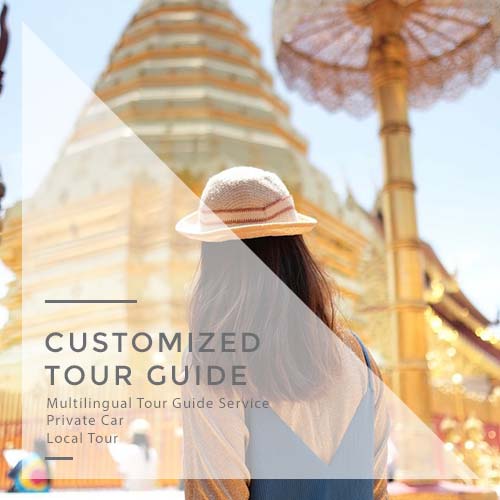The best time to visit Chiang Mai is from November to early February when the weather is sunny, cool and pleasant.
Chiang Mai is one of the most attractive tourist destinations in Thailand, offering visitors many exciting experiences. To enjoy the best of Chiang Mai, one of the crucial factors to consider is choosing the appropriate travel time.
This article includes Chiang Mai’s weather, seasons in Chiang Mai, and the best months to visit Chiang Mai.

Chiang Mai, the biggest city in Northern Thailand, is significantly different from the other part of Thailand. From the food, culture, landscape, to the weather.
Chiang Mai’s Weather By Seasons
Set in the mountainous area of Northern Thailand, Chiang Mai’s climate is very seasonal, with temperatures reaching up to 40°C in summer, and down below 10°C in winter.
Compared to Bangkok and the other southern cities of Thailand, Chiang Mai is slightly cooler and enjoys a relatively lower humidity. Generally, Chiang Mai has 3 main seasons i.e the cool season (November to February), the hot season (March to May), and the rainy season (June to October).

Chiang Mai is surrounded by mountains. The Doi Inthanon National Park, home to Thailand’s tallest mountain, is the most popular attraction in Chiang Mai.
The Cool Season (November to February)
Weather-wise, the cool season which runs from November to mid-February, is the best time to visit Chiang Mai.
This is the most comfortable time of the year, with daytime temperature around 28°C, and the nighttime temperature can drop to 10°C. If you travel up to the mountains, like Doi Inthanon National Park, you might experience the freezing temperature as low as 3°C. On average the coolest month is January.
The weather is most excellent in December and January. The daytime is warm, and cool during the evening and night. You can walk around in shorts and a shirt in the daytime, but a sweater or jacket will be needed after sunset.
These months also have the lowest rainfall, so humidity is low and the sky is blue, without clouds. Since the rain shower is rare, outdoor activities won’t be threatened by bad weather too. This is the ideal time to visit Chiang Mai because the weather is perfect for all kind of activities.

Chiang Mai’s cool and dry season is the perfect time for trekking. The sky is clear and blue. Mountain view is nice and green, and you can see for miles and miles.
Cool Season Is Chiang Mai’s Tourist High Season
Due to this all-round pleasant weather conditions, the cool season is also the tourism high season which sees a very high influx of local and foreign tourists. This also means that accommodation is more expensive at this time of year, and restaurants and places of interest are more crowded.
Particularly if you are visiting Chiang Mai in December and January. People from all over Thailand travel to Chiang Mai to experience the cold weather at the various mountain national parks, and it often causes difficult traffic conditions in the areas especially during the Christmas and New Year’s long holiday.

The highly photogenic Thung Bua Tong Fields is hugely popular with the local tourists. These sunflowers only bloom once a year, around November to December, so plan your trip well.
The much anticipated Loy Krathong and Yee Peng Lantern Festivals are celebrated on the full moon day of the 12th month of Thai’s traditional calendar, which typically falls on the second or third week of November. This is the time Chiang Mai is THE BUSIEST. So be sure to book ahead if you’re travelling during this time of the year because the hotels, train and bus tickets are expected to be fully booked.
Another highlight of the cool weather is the beautiful cherry blossoms/Sakura season. The pink little flowers bloom somewhere from January to early February, varies depending on annual climate.

Chiang Mai is extremely crowded during the 3-days Loy Krathong, and Yee Peng Festival. Tourists from all over the world come to Chiang Mai just to get into this magical festival.

Chiang Mai has cherry blossoms too! There are many places around Chiang Mai where you can see the little pink flowers blooming, around January and early February.
The Hot Season (March to May)
Towards the end of February, the temperature is starting to warm up. The hot season which runs from March to May is Chiang Mai’s hottest time of the year with midday temperatures often climbing beyond 32°C. On average April is the hottest month with daytime temperatures can rise up to 40°C.
Because Chiang Mai hasn’t seen rain for several months the area gets rather dry and sometimes dusty. Many trees lose their leaves and the rice fields are brown stubble – so not as photogenic as the rainy season. The hot season is also generally drained, but with an increased chance of rainfall in May.
Nights during the hot season don’t bring much relief either. So remember to rent a room with air conditioning if you are planning to stay during those months.
The hot season is also the time Chiang Mai suffers from air pollution due to forest fires, and farmers burning their agricultural land to prepare the soil with higher fertility for the next crop.
These fires cause a lot of smoke and dust making the air quality so poor and visibility of mountain views reduced by haze, which probably make March and April the worst months to visit Chiang Mai. Children and elderly with medical problems such as asthma, and respiratory disease should take precautionary measures at this time.

The Chiang Mai’s Grand Canyon is the perfect place for the hot day of Thai summer. This place has become more and more popular among young tourists who love adventures.
In spite of the hot weather, a visit to Chiang Mai in the middle of April is still fun as you can enjoy the Songkran Festival i.e the Thai New Year. Songkran is the biggest and the most important Thai’s festival with the real holiday atmosphere. The schools are closed, and most Thai people travelling back to their home town for the celebration.
Chiang Mai has one of the largest Songkran Festival celebrations in Thailand, along with the celebration in Bangkok and Khon Kaen. You can always cool down with the famous Songkran water splashing!

Songkran Festival takes place every April 13-15. Thousands of tourists come to Chiang Mai at this time to have fun in the crazy water battles and street parties.
The Rainy Season (June to October)
The rainy season which typically runs from June to October isn’t anything like as bad as it sounds, and it’s actually a surprisingly good time to visit Chiang Mai.
Temperature during the rainy season cools down although the air humidity is high (30-65%). This wet weather is caused by the south-west monsoon, arrives from India in the late of May. With the monsoon rains, the sky gets cleaner as all the smoke and dust is washed out and blown away.
Rainy season does not necessarily mean it rains all day. Rainfall is mostly in the afternoon or at night, and it often comes as quick, short blast of a tropical downpour. Very rarely you have a few days when it rains continuously.
When they do, they don’t often last for very long and it gets dry afterward rather quickly lasting an hour or two, rarely severe or prolonged enough to interfere with travel. If you’re prepared with an umbrella and some waterproof clothing, you can actually have a very good time exploring.
Sometimes it does rain heavier and more constant, especially as the monsoons reaching their peak in August and September. It’s a good time to seek shelter in a cafe, museum or spa. However, it is also normal to have several sunny days in a row with completely no rain.

Rice farming season normally begins in May, when the first rain of the year fall. The rice plants reach their full length and greenness during July – September, the peak of the rainy season.
Chiang Mai’s weather in the rainy season is pleasant for sightseeing. One of the best things about visiting the city this time is the charm of monsoon rains that render the nature and scenery at their deepest green.
The natural attractions are perfect and picturesque during the rainy season. This is the time of year the jungle vegetations and paddy fields are at their most lush and green colour. Some of the best exotic fruit is in season and flowers are in colorful bloom, attended by hordes of beautiful butterflies and insects, and the waterfalls – which often dry up in the dry season – are at their most impressive at this time of year.
The rainy season is also the cheapest time to visit Chiang Mai. The period between late April until late October draws the least number of tourists, so accommodation and flight prices drop.
The monsoon is the tourism low season. So if you are looking for a quieter holiday, or if you’re a nature admirer, then this is the time for you.

The waterfall’s splash is stronger and thunderous in the rainy season. It’s magnificent though but please always follow the safety instructions when visiting.

The rainy season is a good time to visit the elephant sanctuary. You won’t get sunburnt, and the elephants are very active during cloudy days.
So .. When Are You Coming To Chiang Mai?
January is the coolest month.
February is the driest month and the month of the Chinese New Year. Thailand has a large ethnic Chinese population so most Chinese-owned business will be closed at this time. This time is also the Chinese tour groups’ peak travel period.
The burning season begins in March, sometimes in February.
April is the warmest month. The Songkran Festival (Thai New Year) fell annually on 13 April.
Temperature cools down midway through May, signaling the end of hot season, and the start of rainy season.
The rainy season begins in June until October. Some national parks are closed during this period.
The monsoon rain reaches its peak in August – September. Rainfalls are heavier and more constant.
October is the “shoulder month”, in between the rainy reason and the incoming tourist peak season. It is the end of rainy season and the weather is great but without a lot of tourists around.
The cool (and dry) season begins in November until February. Weather is perfect for all kind of outdoor activities, and this period is the tourism high season.
The 3~5 days Loy Krathong & Yee Peng Lantern Festivals take place in mid-November. The accommodations in Chiang Mai will be fully booked during the festival week.
December ~ January is the peak travel season. Book early, and plan well in advance for your travel itinerary.

Doi Inthanon National Park is often covered with a thick fog, has high humidity and cold weather all year round.

Many people avoid the rainy season. But we actually think that it is one of the best time to visit Chiang Mai.
WHEN IN CHIANG MAI, YOU MAY NEED A RIDE:
GRAB (UBER) RIDING in Chiang Mai. Taxi Service via Your Phone App
20Baht TO EVERYWHERE in Chiang Mai by RTC Public Bus
LOCAL TRAVEL Guide to taking Songthaew “Two Rows” in Chiang Mai






































